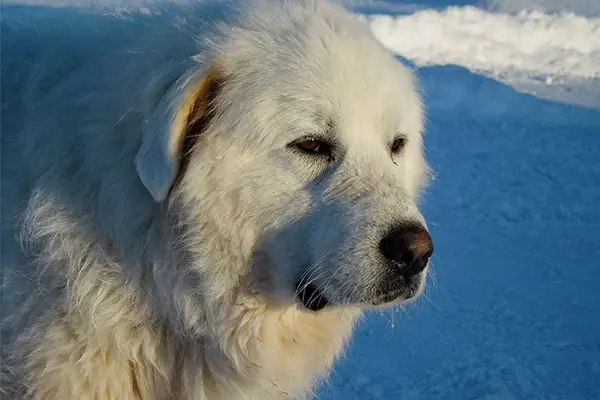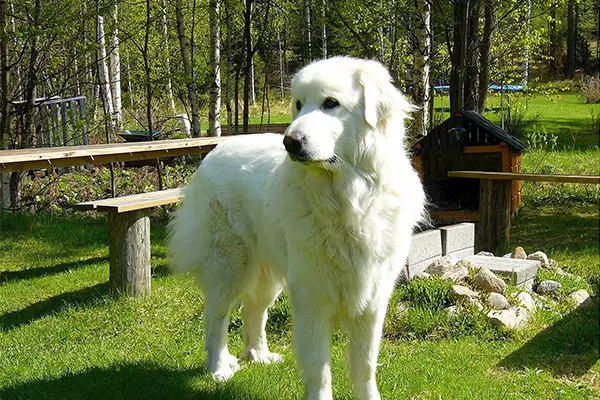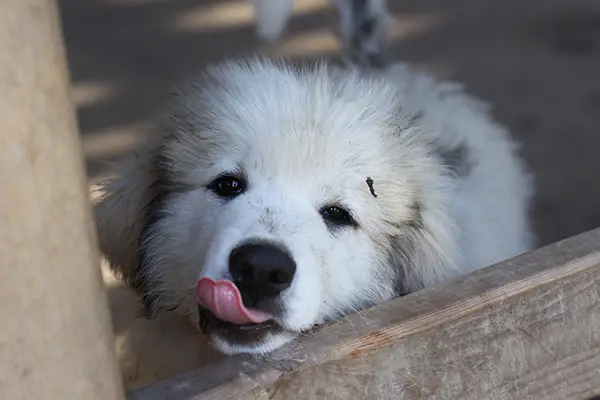The Great Pyrenees is a large-sized dog used as guard dogs for flocks to help shepherds. Their muscular bodies are covered with long coats that can be either straight or slightly wavy. The coat comes in several colors – solid white and white with patches of pale yellow, tan or gray.
These dogs are affectionate, gentle, hardworking, and intelligent. They are not dogs for inexperienced dog owners, as training will require hard work. If trained and socialized well, they make excellent family dogs who are devoted and loyal.

Great Pyrenees Statistics
| Dog Breed Group | Working |
| Breed Size | Large to Giant |
| Height | 27-32 inches (male); 25-29 inches (female) |
| Weight | 100 pounds and up (male); 85 pounds and up (female) |
| Lifespan | 10-12 years |
Great Pyrenees Ratings
| Energy level | |
| Exercise needs | |
| Requires attention | |
| Playfulness | |
| Trainability | |
| Shedding | |
| Grooming | |
| Friendly with family | |
| Friendly with kids | |
| Friendly with strangers | |
| Friendly with other dogs | |
| Prey Drive |
Great Pyrenees History
The Great Pyrenees is believed to have existed centuries ago way back in 1000 BC. The breed was first found in the Pyrenees Mountains, a border between France and Spain, where they got their name.
These dogs were developed to watch shepherd’s flock and deter predators away from livestock. They were considered to be peasant dogs until 1675 when King Louis XIV declared them as Royal Dogs of France.
With that, there was an immediate increase in the demand of the dog breed. French nobles acquired Great Pyrenees dogs to guard their real estates. Even Queen Victoria of England admired the breed and owned some Great Pyrenees.
By 1824, the first of the breed came to America. When the 1900s began, the French started to lose interested in the dogs. Their numbers started to decline. It was only fortunate that they were still present back in their native mountain land.
It was only in the 1930s when the dog breed was seriously imported to America. The American Kennel Club only registered them by 1933.
Now, the Great Pyrenees is one of the most popular family pets in the US. The dogs are also practically useful in guarding livestock.

Temperament
The Great Pyrenees are known for their majestic looks, which match their general temperaments – smart, patient, and calm.
These dogs are known to be well-mannered, serious, and dignified. They don’t make so much noise in the house, especially when they’re adults. They make excellent family pets for those who don’t like any mess inside the house.
The Great Pyrenees are known for being devoted and affectionate to their family. They are especially gentle when it comes to their family’s children and pets. However, this is not the same when it comes to strangers.
Though generally aloof to strangers, the Great Pyrenees are not aggressive dogs. They, however, are protective when the need arises.
Known to be a dog breed left alone to guard mountains, these dogs are independent. Training might come as challenging, but it’s highly essential. Train them with consistency and be firm. These dogs may be stubborn, so make sure to show them who the leader is without acting harshly.
Early socialization is needed too. These dogs may be calm, but they should be socialized as puppies if you want them to be more well-rounded dogs.
Care Requirements
- Nutrition: Great Pyrenees are required to have a daily calorie intake of 2,138 calories. However, active ones would need 3,402 calories. As for puppies, they would need around 1750 daily calories of food. By sticking to this calorie count, you will be able to maintain your dog at the right weight. However, there are other things important than the daily calorie intake, and that is the quality of food. If you want to feed dog food, make sure only to choose those of premium quality. Avoid any fillers and artificial flavors or coloring. For home cooked food, make sure it consists of a lot of protein for muscle build-up. Be aware of what food ingredients your dog is allergic too, and stay away from those.
- Grooming: The Great Pyrenees has a dirt and tangle resistant coat that sheds seasonally. They may not require a lot of grooming, particularly baths, but they do need weekly brushing. If you don’t want hair all over your floor and couch, then this is very important. Brushing should be done daily once the shedding season comes in. For the baths, you can do this every few months or just a few times a year. As these dogs don’t get dirty easily, regular baths are not needed. But, checking and cleaning the ears should be done regularly to prevent ear infection. As for the nails, these should be kept short always. Long nails will cause a lot of discomfort and harm to your dogs.
- Exercise: Though not a highly active breed, Great Pyrenees require a lot of daily activities. This is so they can expel any excess energy they have left, which makes them calm and well-mannered indoors. Daily moderate walks should suffice for these dogs. But if you can give them some work to do like guarding the house or protecting livestock, then that’s better. But if you don’t, then only make sure he gets his mind and body exercised for just a couple of hours a day.
- Health: The Great Pyrenees dogs are generally healthy. However, they may be prone to some of the following diseases.
- Gastric Torsion
- Hip and Elbow Dysplasia
- Patellar Luxation
- Addison’s Disease
- Cataracts
- Entropion
- These dogs are also prone to bone diseases, just like any other large dog breeds. Feeding them the right food and providing them the proper care is highly essential to prevent some, if not all, of these diseases from happening. There are screening tests available that your dog can take, too, if you wish to know if your dog is likely to have one of these diseases.
- Lifespan: The life expectancy of The Great Pyrenees is 10-12 years.

Famous Great Pyrenees
- Belle: The Great Pyrenees character from the movie Belle and Sebastian
Fun Facts about Great Pyrenees
- The Great Pyrenees is an ancient dog breed known to have existed 3000 years ago at the Pyrenean Mountains.
- These dogs were bred to be livestock guard dogs.
- They were named “Royal Dogs of France” in 1675.
- They were brought to the US by a French military officer named Marquis de Lafayette.
- They were one of the dogs used to revive the St. Bernard dogs.
- They helped during World War II as deliverers of artillery supplies over the Pyrenees Mountains.
- These dogs were recognized by the American Kennel Club in 1933.
